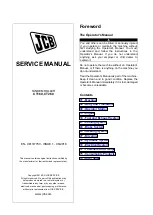
IMPORTANT:
OPW products should be used in compliance with applicable federal, state, provincial, and local laws and regulations. Product selection should be
based on physical specifications and limitations and compatibility with the environment and materials to be handled. OPW MAKES NO WARRANTY OF FITNESS
FOR A PARTICULAR USE. All illustrations and specifications in this literature are based on the latest product information available at the time of publication. OPW
reserves the right to make changes at any time in prices, materials, specifications and models and to discontinue models without notice or obligation.
12
Drylok
®
Dry Disconnect – 1" Coupler Maintenance
1" DRYLOK COUPLERS 5770 SERIES:
WARNING
OPW ENGINEERED SYSTEMS cannot be held
responsible for the integrity of a Field rebuilt product. To minimize the
possibility of physical injury and obtain the best possible functioning
product after rebuilt, it is strongly recommended that the procedures
outlined be followed to Tear down, Re-assemble and Test the product
before placing the unit back into service. Reference the enclosed illus-
trations to facilitate identification of parts.
NOTE:
Remove coupler from service and clean before
attempting to disassemble unit. Do not leave pipe or fittings attached
to coupler because it will be necessary to reach in the threaded end of
the coupler to disassemble. It is suggested that the coupler be secured
in a vice or similar fixture to facilitate working on the unit. Flats on the
sides of the coupler are provided for this purpose.
TEAR DOWN INSTRUCTIONS:
1.
Remove the RAMP/HANDLE (4), by removing GROOVE PIN (9).
(
NOTE:
This pin will only come out one way. It is larger in diame-
ter on one end for retaining purposes). With the GROOVE PIN (9)
removed, the RAMP/HANDLE can be lifted off. With the RAMP/
HANDLE (4) removed, WASHER (11) and BEARING/HANDLE (16) can
be removed and discarded. Next, remove GROOVE PIN (17). Take
caution, as stated above when removing this pin.
2.
It is now possible to pull SHAFT (1) out of the coupler BODY (7).
Insert a small bar through the .19" diameter hole in the SHAFT (1)
to simulate a “T” handle. Now it is possible to pull the shaft with a
significant force to dislodge it. It may be necessary to reach into the
threaded end of the coupler and wiggle the POPPET LINKAGE (2)
and perhaps even rotate the SHAFT to alleviate any binding that may
occur when trying to pull out the SHAFT.
3.
Once the SHAFT (1) is removed, the poppet sub-assembly can be
pushed out the front end of the coupler by tapping or pushing on the
linkage from the threaded end.
WARNING
Do not push the poppet sub-assembly into
the coupler BODY (7)! In other words, do not push it the wrong
way! The poppet sub-assembly will get stuck in the BODY and
subsequent attempts at removal may damage the seal seat.
4.
With the
SHAFT (1)
removed,
O-RING, SHAFT (20),
BUSHING (10)
and
SPACER/BEARING (25)
can be
removed and discarded.
SEAL REPLACEMENT:
There are only three possible leak paths where there
are seals in the coupler body:
•
Coupler O-RING, FACE SEAL (19)
•
Poppet O-RING (8)
•
Coupler O-RING, SHAFT (20)
COUPLER O-RING, FACE SEAL (19)
REPLACEMENT:
1.
Replacement of the coupler O-RING, FACE SEAL (19) is
possible with no disassembly of the coupler. Furthermore,
it is not necessary to remove the coupler from service
CAUTION
Fluid in the coupler will have worked its way
into the o-ring groove behind the o-ring. The backside of the o-ring
will be coated with this fluid even if the unit was cleaned. Take
appropriate measures.
WARNING
Improper removal of o-ring could result
in scratched seal surface in the seal groove. Follow
instructions carefully!
2.
To remove old o-ring, it is best to simply stick it with a thin, sharp
object and pry the local area out of the groove. To avoid scratching
the seal seat, avoid pushing the sharp object completely through
the o-ring.
3.
Grab the pried out section of the o-ring and pull completely out.
4.
Clean groove and check for scratches. Any deep scratches will cause
even a new o-ring to leak. Replace unit if scratches are found.
5.
To install new O-RING, FACE SEAL (19), align o-ring with groove and
push four local areas of the o-ring into the groove at approximately
12 o’clock, 3, 6 and 9 o’clock. Then work the rest of the o-ring into
the groove between the already pushed in sections. If this step is
ignored, and the o-ring is worked in from a single location, a loop
may develop in the o-ring. It will appear the o-ring is too long to fit
in the groove.
HINT:
Recurring O-RING, FACE SEAL failures are a result of
failure to clean coupler and adaptor mating surfaces before
coupling, or a raised surface on the adaptor resulting from a
nick or embedded dirt.










































